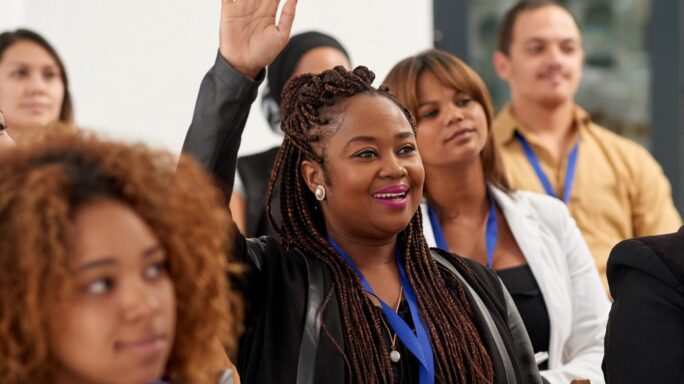Leading people
Changing the narrative of women in tech starts with a mental conversation
We are humans more than we are males or females. There are no male and female dynamics here, only human dynamics. And when you engage from a human level, and you get to know people—you share, participate, get involved—you start to form relationships

Tina Sefotlhelo never planned to have a career in customer service.
As someone who loves a solid debate, Tina always thought she’d study law. And coming from a large family, she had plenty of opportunities to practice her debating skills with her four siblings and nine cousins—although her grandmother preferred the term “argumentative”.
She describes her upbringing on a farm in the Transkei (now part of the Eastern Cape) as comfortable. At the time, the Transkei was an independent republic, and Tina’s grandfather served as a minister. Both her parents were school principals in Umtata. While her parents worked and attended university, Tina, her three siblings, and 10 cousins were raised by her grandmother.
“My grandmother was one of the strongest influences in my life. There were nine girls in our family, and my grandmother made it a point to teach us to be strong and independent. She spent a lot of time building our self-esteem, preaching religiously about who we are in society, encouraging us to walk the talk, be confident, and speak out for what we believe in. She was strict on how we should behave as girls in preparation for our future because childhood behaviour has an impact on how one shows up as an adult. She put a lot of emphasis on us being well-mannered, presentable, and waking up early to prepare for the day.”
After high school, Tina moved to KwaZulu-Natal to start her law degree, but things changed very quickly for her family financially after her grandfather died, and soon after, her father also passed away.
“I had to leave university and move to Johannesburg to find a job. The first thing I landed was a position in a call centre for a short-term insurance provider. It was supposed to be temporary; I intended to work and study and eventually return to university to finish my degree. But the industry grew on me. I fell in love with customer service and working in a team, and I became curious about a career in this space.”
Growth happens outside your comfort zone
Tina stayed with the company for 11 years, working her way up from call centre agent to team leader to operations manager to GM for customer service.
She credits her first employer for much of her success today. “They invested in my growth and laid a solid foundation for me. They taught me everything I needed to know about servicing and speaking to customers, and I was mentored by the then-CEO as part of their Young Aspiring Leadership programme.”
Tina was also exposed to executive forums where critical business decisions were made, and participated in many of the company’s programmes, like the employment equity forum, HIV and AIDS forum, diversity forum, and other community-related forums.
“I knew that, in order to grow, I had to show up and network as much as possible, so that when opportunities came along, my personal brand spoke for itself. I grew a lot professionally, personally, and financially through my activities and involvement, and I’m very grateful for that.”
She followed through on her intention to study while working, but instead of studying law, she chose advanced marketing and business management. She also spent a lot of time studying the insurance industry and its regulations and getting her accreditations required in the Financial Advisory and Intermediary Services industry.
When a pay-tv service provider headhunted Tina, she decided it was time for a change—to explore the growth potential and the opportunity to work in technology.
“After being in the insurance and regulation space for so long, walking into a different industry altogether was exciting. The thought of working in the tech space and exposing myself to the software industry was an interesting dynamic. It also allowed me to put the disciplines I’d studied, like marketing and economics, into practice. Customer demands and expectations are completely different in this space, and—because I had already grown so quickly—I saw it as another opportunity to advance my career, skills, and experience.”
In accepting the pay-tv opportunity, Tina went from managing a team of 250 people to an environment with a customer service team of over 1,000.
“I knew it would stretch me and test my expertise. The fact that they also served customers in Africa was attractive to me, and I wanted to see if I could apply what I had learnt in insurance to a different environment and on a much larger scale.”
And stretch her, it did. Moving from a highly legislative environment dealing with insurance policies and claims to a highly innovative, technologically intensive environment forced Tina out of her comfort zone.
“It was totally different. I was speaking tech language now. I was talking about error codes and translating highly technical troubleshooting information—like fixing a decoder—into simple, step-by-step instructions to help customers do things themselves. At the time, we were moving into the digital self-service space and away from the traditional call centre environment. It was very exciting.”
Opportunity rewards courage
Tina threw herself into learning as much about technology and customer service in the digital space as possible. She stayed in this role for seven years before accepting her current position: Director of Customer Support for Sage Africa and the Middle East and member of the AME Executive team. And although Tina is a huge advocate for technology in customer service today, she’s not sure she would have accepted the position a decade ago because imposter syndrome held her back.
“When you start interacting with technology, you think, my gosh, it’s intimidating and difficult—especially the jargon. If I had been headhunted by Sage back then, I probably would have turned it down because I would have been too intimidated by the industry. I wasn’t comfortable or familiar with the language of software; I hadn’t studied it; what did I know?”
“When I accepted the pay-tv role, it was all new. We were transitioning to tech-based customer service, so I needed to ensure that I understood the product and could provide the service that our customers demanded and that I could transition my team from traditional customer service models to digital, omnichannel ones.”
Tina quickly aligned herself with the product development team and built networks so that she could learn this new language. When the opportunity to join Sage came along, it was an easy move because she was comfortable in the digital space.
But with hindsight and experience comes foresight. And her advice to women who are interested in this space is to be bold, put a stake in the ground, bring themselves forward, and put in the mental and physical work to learn and develop themselves.
“You’ll miss many opportunities to grow if you wait until you’re comfortable.”
Own who you are
“You can’t walk into the tech industry with the mindset that it’s male-dominated, that you won’t make it, and that you are ‘less of’ because you’re female. That’s where failure starts. As women, we need to change our mindsets and walk into things bold and courageous. We need to start believing that we belong in this space, we add value here, and let our results speak for themselves.”
One way to kill imposter syndrome, says Tina, is a willingness to be vulnerable. Working in the software-as-a-service (SaaS) industry, she says the jargon can be “crazy”, but you have to invest in learning and speaking up when you don’t understand something.
“If you’re having a conversation or sitting in a boardroom and they’re talking about something technical that you don’t understand, don’t sit in a corner and shy away. You have to be part of the conversation. And it’s ok to be vulnerable and say, ‘guys, what are you referring to?’ But then your assignment is to leave that boardroom and go and understand, find out what it means so that you can be part of the bigger conversation when it comes. Get into that headspace, do the work, and you will be rewarded. I’ve seen it happen in my own life.”
She credits this mindset to the solid foundation instilled in her by her grandmother.
“She taught us that, as women, we have a voice and we should always use it, but also always know when to use it. The biggest lesson for me was to show up authentically so the world can see me, not a version of myself. She’d often say, ‘Potliza (nickname) my child, the world wants to see you because you are beautiful and have a lot to offer. Own who you are’.”
Tina has made a point of investing in and upskilling herself throughout her career. She believes that having a positive attitude, a growth mindset, and taking ownership of her development have opened many doors and supported her success as a leader.
“We have to stop being emotional about these things and just get involved and do the work. As women, we have an opportunity. It’s our time. There’s a gap to fill—only 20% of executive positions worldwide are occupied by women. There’s room for growth. And the only way we can close the gap is if we get our thinking right and start changing the narrative. Be bold and courageous and show the world what you have to offer. Teach your colleagues how to treat you, and don’t expect things to be given to you; you have to make them happen.”
There are no male and female dynamics, only human ones
We often hear that women bring a different dynamic to the workplace. They’re more empathetic, caring, and sensitive. And businesses with female leaders are more productive, have higher revenue, and have greater stability. But, for Tina, these are human traits that anyone can develop.
Listening to Tina speak about teamwork, respect, and fairness, it’s evident that she brings bucketloads of empathy to her role. Throughout her growth, Tina has reminded herself—through self-education, self-awareness, and self-talk—that she doesn’t ‘work with males’; she works with colleagues, with humans.
“We are humans more than we are males or females. There are no male and female dynamics here, only human dynamics. And when you engage from a human level, and you get to know people—you share, participate, get involved—you start to form relationships. And for me, the easiest relationships are professional ones. A work environment is a professional relationship. It doesn’t need to go deep or be complicated. We navigate professionally. We all have a vested interest in the business; we all signed a contract here. We want the company to grow, I want to grow, you want to grow, so how do we enable that for ourselves? As long as there’s fairness, we’re good. Let’s be fair, see each other’s effort, recognise and value their input, reward them for that, and then everyone will be comfortable.”
Tina doesn’t deny that women experience challenges in the workplace, but she also believes that women must take the lead in developing themselves and changing the narrative.
“What really helps me is that I lead myself and invest in self-awareness. I’ve seen how quickly I can grow when I put in the work. I sign up for courses, share challenges and learn from my colleagues, and make sure that my voice is heard because I belong here. I add value here. It’s a mental conversation in most cases, but we must change our internal narrative before we can change the broader one.”
Tina has been with Sage for about a year and a half and says she is still challenged every day.
“It’s a highly, highly technical environment. But it’s also exciting to take what I’ve accomplished in the traditional customer service and pay-tv spaces and see how I can apply it in a more digital and technical space. I love every moment and the challenge of servicing businesses as opposed to consumers and individual customers, which I did for 19 years. SaaS is fast-paced, the room for error is minimal, and it’s a big responsibility. We’re solving complex challenges for our customers, and it’s an exciting space to be operating in, to always be thinking about what’s next, what we can do differently, and how we can service our customers in new ways. That’s the challenge, and that’s what keeps my fire going.”





Ask the author a question or share your advice